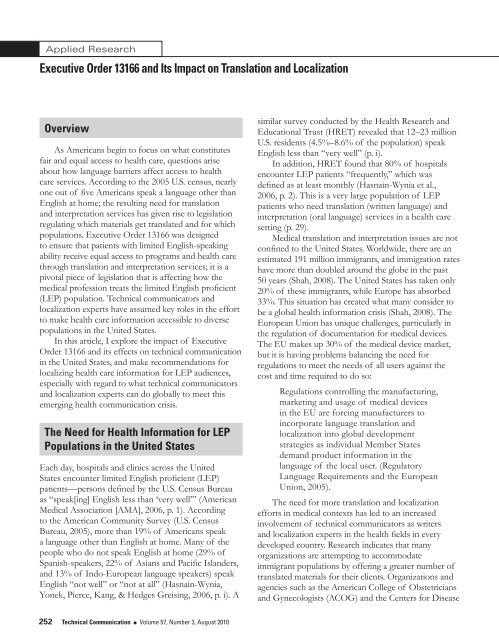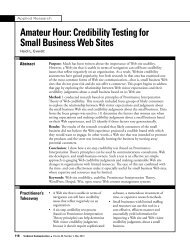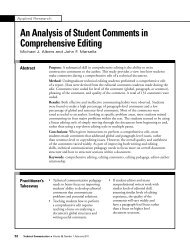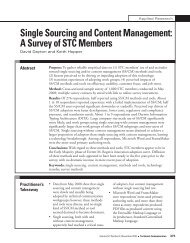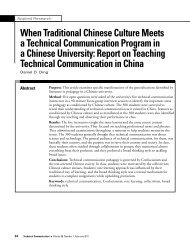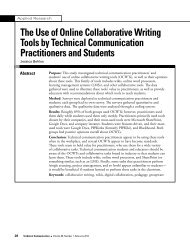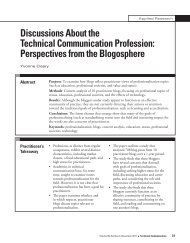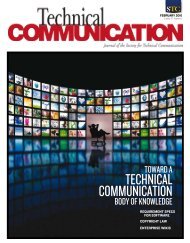Applied ResearchExecutive Order 13166 and Its Impact on Translation and LocalizationOverviewAs Americans begin to focus on what constitutesfair and equal access to health care, questions ariseabout how language barriers affect access to healthcare services. According to the 2005 U.S. census, nearlyone out of five Americans speak a language other thanEnglish at home; the resulting need for translationand interpretation services has given rise to legislationregulating which materials get translated and for whichpopulations. Executive Order 13166 was designedto ensure that patients with limited English-speakingability receive equal access to programs and health carethrough translation and interpretation services; it is apivotal piece of legislation that is affecting how themedical profession treats the limited English proficient(LEP) population. Technical communicators andlocalization experts have assumed key roles in the effortto make health care information accessible to diversepopulations in the United States.In this article, I explore the impact of ExecutiveOrder 13166 and its effects on technical communicationin the United States, and make recommendations forlocalizing health care information for LEP audiences,especially with regard to what technical communicatorsand localization experts can do globally to meet thisemerging health communication crisis.The Need for Health Information for LEPPopulations in the United StatesEach day, hospitals and clinics across the UnitedStates encounter limited English proficient (LEP)patients—persons defined by the U.S. Census Bureauas “speak[ing] English less than ‘very well’” (AmericanMedical Association [AMA], 2006, p. 1). Accordingto the American Community Survey (U.S. CensusBureau, 2005), more than 19% of Americans speaka language other than English at home. Many of thepeople who do not speak English at home (29% ofSpanish-speakers, 22% of Asians and Pacific Islanders,and 13% of Indo-European language speakers) speakEnglish “not well” or “not at all” (Hasnain-Wynia,Yonek, Pierce, Kang, & Hedges Greising, 2006, p. i). Asimilar survey conducted by the Health Research andEducational Trust (HRET) revealed that 12–23 millionU.S. residents (4.5%–8.6% of the population) speakEnglish less than “very well” (p. i).In addition, HRET found that 80% of hospitalsencounter LEP patients “frequently,” which wasdefined as at least monthly (Hasnain-Wynia et al.,2006, p. 2). This is a very large population of LEPpatients who need translation (written language) andinterpretation (oral language) services in a health caresetting (p. 29).Medical translation and interpretation issues are notconfined to the United States. Worldwide, there are anestimated 191 million immigrants, and immigration rateshave more than doubled around the globe in the past50 years (Shah, 2008). The United States has taken only20% of these immigrants, while Europe has absorbed33%. This situation has created what many consider tobe a global health information crisis (Shah, 2008). TheEuropean Union has unique challenges, particularly inthe regulation of documentation for medical devices.The EU makes up 30% of the medical device market,but it is having problems balancing the need forregulations to meet the needs of all users against thecost and time required to do so:Regulations controlling the manufacturing,marketing and usage of medical devicesin the EU are forcing manufacturers toincorporate language translation andlocalization into global developmentstrategies as individual Member Statesdemand product information in thelanguage of the local user. (RegulatoryLanguage Requirements and the EuropeanUnion, 2005).The need for more translation and localizationefforts in medical contexts has led to an increasedinvolvement of technical communicators as writersand localization experts in the health fields in everydeveloped country. Research indicates that manyorganizations are attempting to accommodateimmigrant populations by offering a greater number oftranslated materials for their clients. Organizations andagencies such as the American College of Obstetriciansand Gynecologists (ACOG) and the Centers for Disease252 Technical Communication l Volume 57, Number 3, August 2010
Applied ResearchNicole St. Germaine-McDanielControl (CDC) have been translating and localizinghealth materials in greater numbers since PresidentBill Clinton signed Executive Order 13166 in 2000(St. Germaine-Madison, 2007; St. Germaine-Madison,2009). However, our understanding of LEP populationsin the United States and their needs in the health caresetting is incomplete, because until now the focus haslargely been on industry. Executive Order 13166 hasserved as an impetus for technical communicators inthe United States to study and serve these populationsin a variety of health care contexts, and to examinelocalization needs within these contexts.The United States is by no means the onlydeveloped country that is struggling to accommodateincreasingly diverse populations in the health carecontext. However, it makes for an interesting case study,because until Executive Order 13166 came into being,the United States had no regulations regarding therequired amount or quality of translations for medicalcontexts. Examining how technical communicators arereacting to the monumental demand for revision ofhealth care documentation to comply with the executiveorder can help organizations facing this pressure judgetheir own progress and perhaps learn from the mistakesmade and the unique approaches taken by some U.S.health care agencies.Overview of Executive Order 13166In August 2000, President Bill Clinton issuedExecutive Order 13166: Improving Access to Servicesfor Persons with Limited English Proficiency. Theintent of this order was twofold: (1) to better enforcean existing act and (2) to impose a new obligation forall federal agencies to meet these nondiscriminationstandards.Regarding the first intent, Title VI of the CivilRights Act of 1965 “prohibits recipients of federalfinancial assistance from discriminating based onnational origin by, among other things, failing to providemeaningful access to individuals who are limited Englishproficient” (Limited English Proficiency Web site).Title VI, in effect, mandates that “persons with limitedEnglish proficiency get meaningful access to federallyfunded programs” (Wong, 2004, p. 2). Many agencies,both public and private, receive some sort of federalassistance. In the context of health care, if a clinic,practice, or hospital accepts Medicaid or Medicare, thisconstitutes federal assistance, even if only one area ofthe hospital or clinic accepts federal funding (Schroeder,2002). This includes most “hospitals, doctor’s offices,nursing homes, managed care organizations, stateMedicaid agencies, home health agencies, health serviceproviders, and social service organizations” (Sampson,2006, p. 134).Adapting to Executive Order 13166In response to this mandate, hospitals, clinics, andother health care providers across the country havebeen scrambling to provide translated materials andinterpreter assistance to their target users. Even10 years later, many of these institutions are stillworking to increase their compliance with the order(Barrett, Dyer, & Westpheling, 2008), which meansthat technical writers and localization experts in thehealth care fields will have work for years to comejust to make current programs, clinics, and hospitalscompliant.The language-assistance part of the order isintended to help LEP patients obtain federallysupported health services. In the “Statement by thePresident,” Clinton expressed his desire to ensure equalaccess for LEP patients in the health care setting: “Iam concerned that language barriers are preventing theFederal Government and recipients of federal financialassistance from effectively serving a large number ofpeople in the country who are eligible to participate intheir programs” (Clinton, 2000). According to CindyWong (2004), “This Executive Order provides ethicaland statutory foundations for the provision of languageassistance in health care on the basis of ensuringmeaningful access to federally funded programs” (p. 4).Helping LEP patients access programs such asMedicare and Medicaid is especially important, becauseLEP patients are less likely to enroll in federallyfunded programs and more likely to seek treatment atemergency rooms than to go to a clinic or urgent carefacility. This situation has been called the “languagebarrier premium” (Sampson, 2006, p. 14). It drivesup the cost of health care in the long run, becauseVolume 57, Number 3, August 2010 l Technical Communication 253
- Page 1 and 2: AUGUST 2010Volume 57 Number 3SPECIA
- Page 3 and 4: PresidentMichael A. HughesVice Pres
- Page 5 and 6: VoLuME 57, NuMBER 3AUGUST 2010ISSN
- Page 7 and 8: Guest EditorialKirk St.Amant and Ma
- Page 9: Applied ResearchTechnical Communica
- Page 13 and 14: Applied ResearchNicole St. Germaine
- Page 15 and 16: Applied ResearchNicole St. Germaine
- Page 17 and 18: Applied ResearchNicole St. Germaine
- Page 19 and 20: Applied ResearchNicole St. Germaine
- Page 21 and 22: Applied ResearchNicole St. Germaine
- Page 23 and 24: Applied ResearchNicole St. Germaine
- Page 25 and 26: Applied TheoryTatiana BatovaIntrodu
- Page 27 and 28: Applied TheoryTatiana BatovaMoreno,
- Page 29 and 30: Applied TheoryTatiana BatovaThe Uni
- Page 31 and 32: Applied TheoryTatiana Batovadoctors
- Page 33 and 34: Applied TheoryTatiana BatovaTo addr
- Page 35 and 36: Applied TheoryTatiana Batovathe loc
- Page 37 and 38: Applied TheoryTatiana BatovaJohnson
- Page 39 and 40: Applied TheoryTatiana BatovaInterna
- Page 41 and 42: Applied TheoryMcKee and PorterIntro
- Page 43 and 44: Applied TheoryMcKee and PorterFor e
- Page 45 and 46: Applied TheoryMcKee and Porterpubli
- Page 47 and 48: Applied TheoryMcKee and PorterBecau
- Page 49 and 50: Applied TheoryMcKee and Porterof th
- Page 51 and 52: Applied TheoryMcKee and Porterwith
- Page 53 and 54: Applied TheoryMcKee and PorterA Cop
- Page 55 and 56: Applied TheoryMcKee and PorterConte
- Page 57 and 58: Applied TheoryMcKee and PorterWalto
- Page 59 and 60: Applied ResearchLiza PottsIntroduct
- Page 61 and 62:
Applied ResearchLiza Pottsdoes not
- Page 63 and 64:
Applied ResearchLiza PottsUser’s
- Page 65 and 66:
Applied ResearchLiza Pottsactors, t
- Page 67 and 68:
Applied ResearchLiza PottsDRM has a
- Page 69 and 70:
Applied ResearchLiza Pottsmake bett
- Page 71 and 72:
Applied ResearchLiza PottsOne viewe
- Page 73 and 74:
Applied ResearchLiza Pottsinvolved
- Page 75 and 76:
Applied ResearchLiza PottsHayhoe, G
- Page 77 and 78:
Applied ResearchInternational Fair
- Page 79 and 80:
Applied ResearchTyAnna K. Herringto
- Page 81 and 82:
Applied ResearchTyAnna K. Herringto
- Page 83 and 84:
Applied ResearchTyAnna K. Herringto
- Page 85 and 86:
Applied ResearchTyAnna K. Herringto
- Page 87 and 88:
Applied ResearchTyAnna K. Herringto
- Page 89 and 90:
Book ReviewsWriting Successful Scie
- Page 91 and 92:
Book ReviewsThe Process: Business P
- Page 93 and 94:
Book ReviewsHCI Beyond the GUI: Des
- Page 95 and 96:
Book ReviewsOrigins of the Specious
- Page 97 and 98:
Book Reviewsgenre, and process, top
- Page 99 and 100:
Book ReviewsPart One goes from the
- Page 101 and 102:
Book Reviewsrather than writers, an
- Page 103 and 104:
Book ReviewsHow to Write Fast Under
- Page 105 and 106:
Book Reviewsmanagement system (CMS)
- Page 107 and 108:
Book Reviewsnearly strangled when h
- Page 109 and 110:
Book Reviewsinteractive TV model)
- Page 111 and 112:
Book ReviewsOtherwise, Beech shows
- Page 113 and 114:
Book Reviewssuch as blog, I found m
- Page 115 and 116:
Book Reviewsemployees and effective
- Page 117 and 118:
Recent & RelevantSherry Southard, E
- Page 119 and 120:
Recent & RelevantRecent & RelevantC
- Page 121 and 122:
Recent & RelevantRecent & RelevantE
- Page 123 and 124:
Recent & Relevantworking in a langu
- Page 125 and 126:
Recent & RelevantWhat’s the big d
- Page 127 and 128:
Recent & RelevantScientific Writing
- Page 129 and 130:
Recent & Relevantapplicability. Man
- Page 131:
Did You Missthe Summit?Don’t miss


